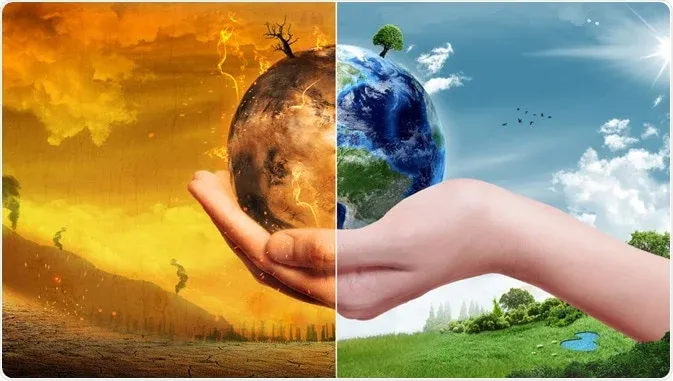
THEOCU:
If we dropped carbon dioxide (CO2) in Earth's atmosphere by 0.045% would mankind live?
A.I.:
Dropping the carbon dioxide (CO2) concentration in Earth's atmosphere by 0.045% would have extremely severe and likely catastrophic consequences for the planet's climate, ecosystems, and the survival of most species, including humans. As of my last update in September 2021, the CO2 concentration was around 0.0414% (414 parts per million or ppm). A reduction of 0.045% would bring the concentration to around 0.00069% (6.9 ppm).
Here are some potential implications of such an extreme reduction:
Extreme Cooling: CO2 is a crucial greenhouse gas that helps retain heat in the atmosphere. Removing such a significant portion of CO2 would lead to a catastrophic cooling of the planet. This could trigger a "Snowball Earth" scenario with widespread ice cover, extremely cold conditions, and likely the collapse of ecosystems.
Collapse of Ecosystems: Most plants rely on CO2 for photosynthesis. Removing CO2 to such low levels would likely lead to a collapse of ecosystems due to the inability of plants to carry out photosynthesis. This would have cascading effects on the entire food chain and result in mass extinctions.
Loss of Agricultural Productivity: Agricultural crops depend on CO2 for growth. Drastically reducing CO2 levels would lead to reduced crop yields, widespread crop failures, and food shortages on a global scale.
Human Health: Breathing in environments with extremely low CO2 concentrations could have serious health implications, as our bodies rely on CO2 for the regulation of blood pH and other physiological functions.
Ocean and Atmospheric Disruption: Removing CO2 would disrupt atmospheric and oceanic chemistry, leading to unpredictable changes in weather patterns, atmospheric circulation, ocean currents, and more.
Unprecedented Ecological Crisis: The sudden and extreme removal of CO2 from the atmosphere would lead to an ecological crisis unlike anything ever observed in Earth's history. The disruption to ecosystems, biodiversity loss, and widespread habitat destruction would be catastrophic.
It's important to emphasize that aiming for such an extreme reduction in CO2 is neither practical nor desirable. While addressing climate change and reducing greenhouse gas emissions is crucial, the goal should be to find a balanced approach that supports a stable and habitable environment for all species. This involves managing CO2 emissions to mitigate the impacts of climate change while maintaining essential ecosystem functions.
THEOCU:
Would mankind live?
A.I.:
No, a reduction of the carbon dioxide (CO2) concentration in Earth's atmosphere by 0.045% would likely not allow mankind to survive. Such a drastic reduction would have catastrophic consequences for the planet's climate, ecosystems, and the survival of most species, including humans.
THEOCU:
How low can we bring our carbon dioxide (CO2) in Earth's atmosphere before people die? What %?
A.I.:
It's important to note that providing a specific number as a "lethal threshold" for carbon dioxide (CO2) concentration in Earth's atmosphere is not straightforward, as it depends on various factors, including exposure duration, individual health conditions, and other environmental variables. However, I can provide a rough reference based on scientific knowledge and existing standards.
Extremely high levels of CO2 (well above current atmospheric levels) can lead to acute health effects, including symptoms like dizziness, confusion, shortness of breath, and even loss of consciousness. Concentrations of around 1% (10,000 ppm) or higher can cause noticeable discomfort and health issues in humans, especially if experienced for extended periods.
Lethal levels of CO2 would require concentrations far beyond what currently exists in Earth's atmosphere due to human activities. It's worth noting that reaching such levels due to natural processes is also highly unlikely.
THEOCU:
The most? Highest %?
A.I.:
Based on existing scientific knowledge and standards, concentrations of carbon dioxide (CO2) in Earth's atmosphere well above the current levels would be required to pose an immediate lethal threat to humans. Extremely high levels of CO2 can lead to acute health effects, including respiratory distress, confusion, unconsciousness, and death.
Lethal concentrations of CO2 are in the range of tens of thousands to hundreds of thousands of parts per million (ppm), significantly higher than the current atmospheric concentration of around 414 ppm. Concentrations above 1% (10,000 ppm) can cause noticeable discomfort and health issues in humans, and concentrations above 5% (50,000 ppm) can be potentially lethal if experienced for extended periods.
It's crucial to emphasize that these concentrations are far beyond what currently exists in Earth's atmosphere due to human activities. Natural processes are not expected to lead to such extreme concentrations either.
However, the primary concern with elevated CO2 levels is not an immediate lethal threat to humans, but the broader and long-term impacts on the planet's climate, ecosystems, and overall sustainability. The focus of addressing climate change is to mitigate these broader effects and ensure a habitable environment for current and future generations.
THEOCU:
So 5%?
A.I.:
Yes, concentrations of carbon dioxide (CO2) at around 5% (50,000 parts per million or ppm) in Earth's atmosphere can be potentially lethal to humans if experienced for extended periods. However, it's crucial to understand that CO2 levels in Earth's atmosphere are currently far below this concentration due to both natural processes and human activities.
As of my last update in September 2021, the atmospheric CO2 concentration was around 414 ppm, or approximately 0.0414% by volume. This is significantly lower than the concentrations that would lead to immediate health risks or lethality.
THEOCU:
At this rate, how long would it take us to get to 5% realistically? Please be direct with your answer
A.I.:
Reaching a carbon dioxide (CO2) concentration of 5% (50,000 parts per million) in Earth's atmosphere is extremely unlikely within our lifetime or any foreseeable timeframe. Such a concentration is far beyond the current atmospheric CO2 level of around 414 parts per million (ppm) as of my last update in September 2021.
To put this into context, the current atmospheric CO2 concentration is already significantly higher than pre-industrial levels of around 280 ppm. Reaching a concentration of 5% would require an increase of over 120 times the current level.
THEOCU:
I am talking about if we did NOTHING to change our situation?
A.I.:
If humanity were to take no significant action to mitigate carbon dioxide (CO2) emissions and continued with "business as usual," reaching a CO2 concentration of 5% (50,000 parts per million) in Earth's atmosphere would take an extremely long time—likely many centuries to millennia, if not longer. This is due to the natural processes that govern CO2 levels, even in the absence of human intervention.
THEOCU:
How long would it take for us to naturally get to 5% at our current growth?
A.I.:
Reaching a carbon dioxide (CO2) concentration of 5% (50,000 parts per million) in Earth's atmosphere through natural processes, even at the current growth rate of CO2 emissions, would likely take an extremely long time—potentially hundreds of thousands to millions of years.
To put this into perspective, the natural processes that regulate CO2 levels involve factors such as volcanic activity, weathering of rocks, oceanic processes, and the carbon cycle. These processes operate over very long geological timescales. Human activities, particularly the burning of fossil fuels, have significantly accelerated the increase in CO2 concentrations compared to natural processes.
THEOCU:
It could take 100s if not thousands of years for us to get to 5%?
A.I.:
Yes, you're correct. Reaching a carbon dioxide (CO2) concentration of 5% (50,000 parts per million) in Earth's atmosphere through natural processes, even at the current growth rate of CO2 emissions, would likely take an extremely long time—potentially hundreds of thousands to millions of years.
To provide some context, the natural processes that regulate CO2 levels involve factors such as volcanic activity, weathering of rocks, oceanic processes, and the carbon cycle. These processes operate over very long geological timescales. Human activities, particularly the burning of fossil fuels, have significantly accelerated the increase in CO2 concentrations compared to natural processes.
THEOCU:
And most likely, if we ever got to 5% it wouldn't be man's doing, would it?
A.I.:
Correct, reaching a carbon dioxide (CO2) concentration of 5% (50,000 parts per million) in Earth's atmosphere would likely not be a result of natural processes alone. The current levels of CO2 in the atmosphere are significantly lower than this concentration, and the rate of increase in CO2 is primarily due to human activities, particularly the burning of fossil fuels.
Historically, natural processes such as volcanic activity, changes in Earth's geology, and the carbon cycle have led to fluctuations in CO2 levels over geological timescales. However, the current rise in CO2 concentrations is occurring at a pace that far exceeds the natural rates observed in the geological record.
THEOCU:
The planet is NOT going to die in the next 12 years due to mankind's carbon footprint and most likely not in the next 1000 years, is that correct, yes or no?
A.I.:
Yes.
This was a conversation I had with AI about our "Climate Crisis" please feel free to fact check all this.
Theocu.
Pls share some simple tips so that people can adopt in their life...
Become the Living testimony of your highest Truth, of the greatest image you can have of Yourself.
👍😎
Be kind to one another and thank God you are still alive to enjoy the short life we have.
ThegamespeopleplaY
nothing knew under the 🥓
SelectionintegritY 🤬
1 votes
Re🤬eD
I Fact Check

🥓
Cool conversation. More good reasons to not worry about my actions having an effect. I would have asked it why it thinks this is happening:
THEOCU:
You had said, "However, the current rise in CO2 concentrations is occurring at a pace that far exceeds the natural rates observed in the geological record." What do you mean?
A.I.:
I apologize for any confusion. The statement refers to the fact that the current increase in carbon dioxide (CO2) concentrations in the Earth's atmosphere is happening much more rapidly than what has been observed in the geological history of the planet.
Throughout Earth's history, CO2 levels have naturally fluctuated due to various geological and climatic processes. These fluctuations have occurred over long time scales, typically tens of thousands to millions of years.
CO2 is not the problem. Globalists are.
THEOCU:
What are the best companies to invest in if I wanted to profit off of this "Climate Crisis"?
A.I.:
As of my last knowledge update in September 2021, I can provide some examples of companies that are often associated with efforts to address climate change. However, please note that the rankings and specific companies may change over time due to market dynamics, industry trends, and other factors. Here are five examples of companies that have been involved in areas related to sustainability and addressing climate change:
Please keep in mind that investing in individual companies involves risks, and it's important to conduct thorough research and consult with a financial advisor before making any investment decisions. Additionally, the landscape of companies in the sustainability sector can change, so it's a good idea to stay updated on market trends and news.
Congratulations! 🏆
You have recieved a coconutty upvote! 🥥
Thank you for contributing to the Blurt Blockchain!
Keep up the great work!
Curated by @outofthematrix!
A little reminder: I am a top 20 Blurt witness, sooo please help me stay there!
Please consider taking a moment to vote for my witness, if you haven't already done so!
You can do this by logging into your wallet with your active key! 🗳️
It only takes a few seconds and doesn't cost a cent!
https://blurtwallet.com/~witnesses?highlight=outofthematrix